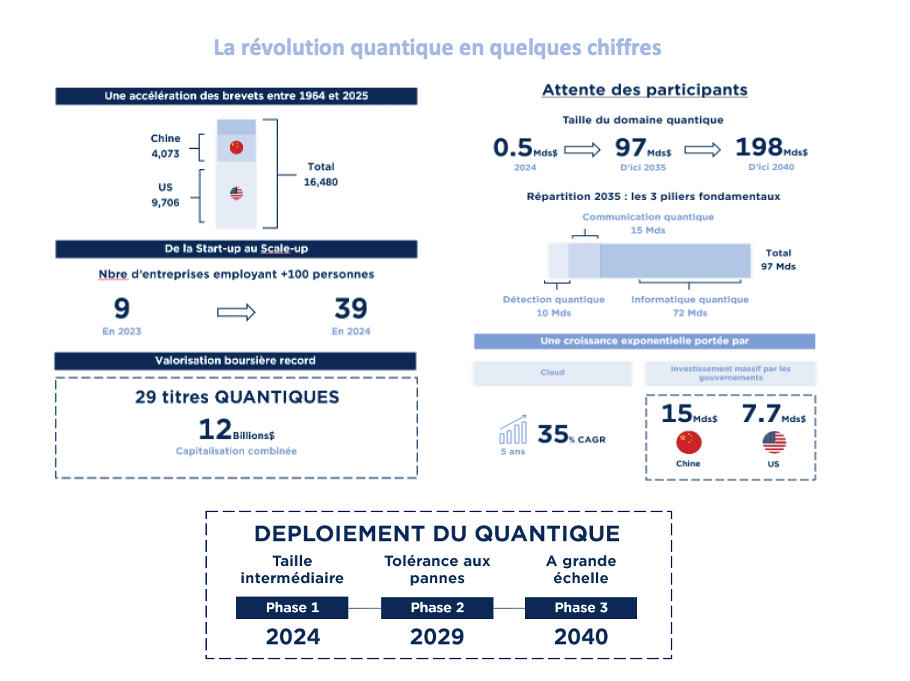The impact of quantum computing on AI
The arrival of quantum chips such as Microsoft’s “Majorana 1” and Google’s “Willow” is revolutionising information processing by making it faster and more efficient. By enabling faster and more accurate probabilistic calculations, quantum computing amplifies the capabilities of AI models, paving the way for advances in the areas of pattern recognition, optimisation and machine learning. By introducing superposition and entanglement into data processing, it offers AI the ability to “think” in a more intuitive way, reducing computing costs and energy consumption, two major challenges for the sector.
The basics of quantum mechanics and the three main concepts
Quantum mechanics, the heart of quantum computing, is based on principles that are unique and paradoxical to our classical understanding, such as:
1. The wave function: illustrates that particles and waves can exhibit interchangeable properties, influencing the concept of probabilities and interferences that is crucial for quantum calculations.
2. The principle of superposition: allows a particle to be in several states simultaneously, paving the way for exponential calculations until a measurement defines a concrete state.
3. Intrication: refers to the instantaneous and remote correlation of bound particles, facilitating instantaneous communications over vast distances

By enabling faster and more accurate probabilistic calculations, quantum computing amplifies the capabilities of AI models. (Photo: DR)
The quantum technology market
Currently in a growth phase, The quantum field is still modest in scale compared to its estimated potential. In 2024, it was valued at just $0.5bn. However, industry projections and analyses forecast significant expansion, anticipating a market value of $22bn by 2030. This growth will benefit from strategic investments in quantum technology research and development, fuelling a rapid evolution towards viable commercial applications.
According to a McKinsey report in June 2025, the three pillars of quantum technology – quantum information, quantum communication and quantum sensing – could generate up to $97bn in revenue worldwide by 2035.
Quantum computing will capture most of this revenue, rising from $4bn in 2024 to $72bn in 2035. While quantum technology will have an impact on many sectors, the chemical industries, life sciences, finance and mobility will see the strongest growth.

The quantum revolution in a few figures. (Screenshot: Paperjam; Source: Edmond de Rotschild)
Current status and key milestones in the quantum world
Although quantum computing has made significant progress, it still faces technical obstacles. Quantum computers, which are sensitive to noise and errors, require hardware innovations before they become commercially viable. Most experts estimate that practical applications could emerge within five years, stimulating a move towards wider adoption. At the same time, technology giants such as Google, IBM and Amazon continue to invest heavily in quantum research, accelerating its maturation.
The main challenges of quantum
The main quantum-related challenges include noise management and the correction of errors triggered by the sensitivity of qubits (quantum information storage units). Another crucial challenge lies in improving the scaling of systems to give them the robustness needed for complex applications. Despite advances in quantum mechanics, the technology still needs significant fine-tuning to overcome these obstacles and realise its full potential. The latest advances in quantum physics, crowned by the Nobel Prize in Physics awarded to the trio J. Clarke, JM. Martinis and M. Devoret led to the discovery of the tunnel effect, opening up a path of research into quantum computers.
Diverse and promising applications
The potential applications of quantum computing are vast, affecting sectors such as:
Finance: hyper-fast calculations to optimise risk models. Fraud detection and trade optimisation.
Pharmaceuticals: accelerating drug discovery through advanced simulation of molecular interactions.
Logistics and energy: optimising supply chains and maximising the efficiency of electricity networks.
Autonomy and sensing: improved imaging and sensor technologies, enhanced by quantum systems.
Artificial intelligence: acceleration of machine learning.
Costs associated with quantum computing
There are significant costs associated with the mass introduction of quantum computing, not least because of the delicate materials and environment required to operate them. The infrastructures dedicated to hosting quantum computers require significant investment, but the prospects of a return on investment are encouraging researchers and investors to persevere. In the medium term, reduced operating costs and increased performance could make this technology economically viable.
Communication networks and quantum
Quantum communication, exploiting the principles of entanglement and superposition, offers ultra-secure data transfer possibilities. The distributed and interconnected nature of these systems promises revolutionary communication paradigms, emulating traditional Internet networks with enhanced security. These quantum networks could also transform the way AI interacts and shares data in real time in a distributed environment.
Advancing as a catalytic technology, quantum computing promises to propel AI towards innovative horizons. Although still in development, its challenges and costs are outweighed by its scientific and commercial opportunities. By transcending classical computing principles, it represents a real turning point for the industry, ushering in an era of collaboration and technological co-evolution. As its applications begin to unfold, the potential of quantum computing in the global digital transformation continues to fuel previously feverish anticipation.
You don’t need to understand the bewildering complexities of quantum mechanics to appreciate how crucial these technologies could soon become. The world is moving at breakneck speed, one qubit at a time, and it’s hard to say at this point whether the United States or China will gain the upper hand in this frantic race.

